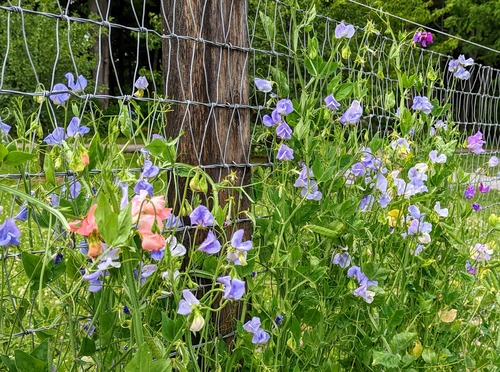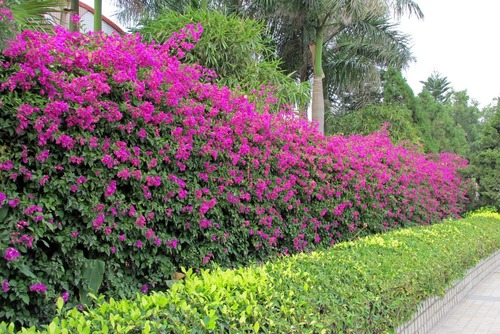Choosing the right flowers for landscaping along your fence can dramatically enhance the look of your garden, providing a vibrant backdrop and adding depth to your outdoor space. Whether you prefer classic climbers like clematis and climbing roses or bold, tropical options like trumpet vine and bougainvillea, these eight flowers offer a range of styles and colors to suit any garden aesthetic. With proper care and attention, these beautiful blooms will transform your fence into a stunning floral feature that you can enjoy throughout the growing season.
By incorporating these flowers into your landscape, you can create a harmonious, beautiful garden that blends seamlessly with your fence and brings new life to your yard.
1. Clematis (Clematis spp.)

Clematis is a popular choice for landscaping along fences, thanks to its climbing ability and show-stopping blooms. These flowers come in various colors such as purple, pink, white, and red, allowing you to customize your garden’s palette. It is a natural climber that, when planted at the base of a fence, gracefully winds its way up to create a stunning vertical floral display. With its long-lasting flowers, clematis not only beautifies fences but also pairs well with roses or other shrubs, enhancing the overall appeal of your garden.
Thriving in full sun to partial shade, this vine requires well-drained soil and benefits from regular pruning to encourage healthy growth and abundant blooms.
2. Climbing Roses (Rosa spp.)

Roses are a timeless favorite in gardens, and climbing varieties are perfect for adding elegance and charm to your fence, as they can easily be trained to grow along them, creating a cascade of blooms that adds a romantic touch to your garden. Their fragrant flowers bloom in a wide range of colors, from soft pastels to bold reds, making them versatile for any landscape.
They thrive in full sun and prefer fertile, well-draining soil, with regular pruning helping to manage their growth and encourage a second round of flowers.
3. Honeysuckle (Lonicera spp.)

Honeysuckle is an excellent climbing plant for fences, featuring tubular, sweetly fragrant flowers that attract pollinators like hummingbirds and butterflies. Blooming in vibrant shades of yellow, red, pink, and white, it adds a splash of color and variety to any garden. This fast-growing vine can quickly cover large sections of a fence, making it ideal for those seeking dense coverage or additional privacy. With its lovely scent and wildlife appeal, honeysuckle is a perfect choice for gardeners who want both beauty and biodiversity along their fences.
This flower thrives in full sun to partial shade and prefers well-drained soil, though it requires monitoring to prevent it from becoming invasive
4. Morning Glory (Ipomoea spp.)

Morning glory, known for its bright trumpet-shaped flowers, is a fast-growing vine that brings a vibrant burst of color to your fence. These blooms open in the morning and close by afternoon, adding a dynamic touch to your garden. Morning glories rapidly climb fences, making them ideal for filling large spaces and providing a vivid, colorful display that can completely cover a fence in just one season. With their striking hues of blue, pink, and purple, morning glories continuously brighten up your garden, offering an ever-changing display of fresh blooms each day.
They thrive in full sun and can adapt to various soils, requiring minimal maintenance, though regular trimming may be necessary due to their aggressive growth.
5. Trumpet Vine (Campsis radicans)

Trumpet vines are ideal for gardeners looking to bring a tropical touch to their fence, with their vigorous growth and large, trumpet-shaped flowers in bold shades of orange, red, and yellow. These striking blooms are known to attract hummingbirds, adding life and color to your garden. Trumpet vines are fast-growing and can quickly cover a fence, providing a lush, vibrant backdrop that adds height and drama to your landscape. With their bold, tropical appearance, trumpet vines transform a plain fence into a show-stopping garden feature.
Growing well in full sun and adaptable to most soil types, they require regular pruning to prevent them from becoming invasive.
6. Wisteria (Wisteria spp.)

Wisteria is admired for its cascading clusters of lavender, purple, blue, or white blooms that dangle gracefully, resembling delicate chandeliers. It stands out as one of the most visually captivating flowers you can grow along a fence. With its vigorous climbing habit and drooping, fragrant blossoms, wisteria has the ability to transform a simple fence into a breathtaking floral display, enriching the sensory appeal of your garden. The graceful, waterfall-like clusters of wisteria flowers will undoubtedly make your fence a striking focal point in the landscape.
This vine grows happily in full sunlight and well-drained soil, though regular pruning is necessary to keep its size in check, as it can grow quite large.
7. Sweet Pea (Lathyrus odoratus)

Sweet peas are loved for their delicate, vibrant blossoms and captivating fragrance. These charming climbing annuals bring a lively splash of color to fences, blooming in a range of hues including pink, purple, red, and white. Their twining vines can be easily guided along a fence, where they create a whimsical and enchanting floral display, infusing your garden with charm. With their sweet scent and gentle beauty, sweet peas are a delightful addition to any fence, making them an essential choice for enhancing your garden’s appeal.
Sweet peas prefers to grow in full sunlight and well-drained soil, needing regular watering and occasional deadheading to ensure continuous flowering.
8. Bougainvillea (Bougainvillea spp.)

Bougainvillea is a vibrant tropical vine known for its striking, paper-like blossoms in bold hues of magenta, purple, orange, and red. It’s an excellent choice for those wanting to introduce a burst of color to their fence. This vine thrives in warm climates, flourishing along fences with its vivid flowers that can last for months. The rich, eye-catching colors of bougainvillea create a dramatic contrast against a plain fence, making it a favorite for Mediterranean and tropical-inspired gardens.
Once established, bougainvillea is drought-tolerant, making it an easy-care option for gardeners seeking a low-maintenance yet visually impactful plant. It prefers full sunlight and well-drained soil, with occasional pruning helping to maintain its shape and encourage further blooming.